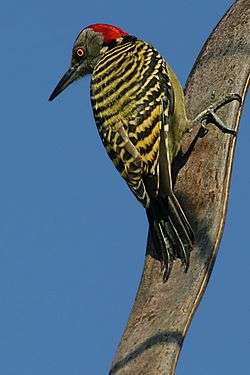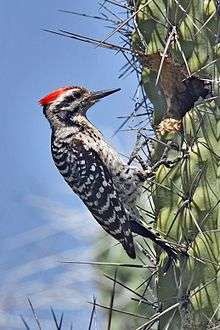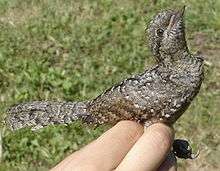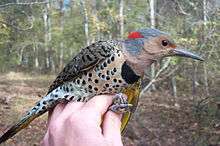Woodpecker
| Woodpecker Temporal range: Late Oligocene to present | |
|---|---|
 | |
| Hispaniolan woodpecker
| |
| Scientific classification | |
| Kingdom: | Animalia |
| Phylum: | Chordata |
| Class: | Aves |
| Order: | Piciformes |
| Suborder: | Pici |
| Family: | Picidae Vigors, 1825 |
| Subfamilies | |
|
Jynginae – wrynecks | |
The woodpeckers are part of the Picidae family, a group of near-passerine birds that also consist of piculets, wrynecks, and sapsuckers. Members of this family are found worldwide, except for Australia, New Guinea, New Zealand, Madagascar, and the extreme polar regions. Most species live in forests or woodland habitats, although a few species are known to live in treeless areas, such as rocky hillsides and deserts.
The Picidae are just one of eight living families in the order Piciformes. Other members of Piciformes, such as the jacamars, puffbirds, barbets, toucans, and honeyguides, have traditionally been thought to be closely related to the woodpeckers, piculets, wrynecks, and sapsuckers. More recently, DNA sequence analyses have confirmed this view.[1]
There are about 200 species and about 30 genera in this family. Many species are threatened or endangered due to loss of habitat or habitat fragmentation.
General characteristics

Members of the family Picidae have strong bills for drilling and drumming on trees and long sticky tongues for extracting food.[2] Woodpecker bills are typically longer, sharper and stronger than the bills of piculets and wrynecks; however, their morphology is very similar. The bill's chisel-like tip is kept sharp by the pecking action in birds that regularly use it on wood. The beak consists of three layers; an outer sheath called rhamphotheca, made of scales formed from keratin proteins, an inner layer of bone which has a large cavity and mineralized collagen fibers, and a middle layer made of porous bone which connects the two other layers. Combined, this anatomy helps the beak absorb mechanical stress.[3] Species of woodpecker and flicker that use their bills in soil or for probing as opposed to regular hammering tend to have longer and more decurved bills. Due to their smaller bill size, many piculets and wrynecks will forage in decaying wood more often than woodpeckers. The long sticky tongues, which possess bristles, aid these birds in grabbing and extracting insects deep within a hole of a tree. It had been reported that the tongue was used to spear grubs, but more detailed studies published in 2004 have shown that the tongue instead wraps around the prey before being pulled out.[4]
Many of the foraging, breeding and signaling behaviors of woodpeckers involve drumming and hammering using the bill.[5] To prevent brain damage from the rapid and repeated impacts, woodpeckers have a number of physical features designed to protect the brain. These include a relatively small and smooth brain, narrow subdural space, little cerebrospinal fluid (CSF) surrounding it to prevent it from moving back and forth inside the skull during pecking, the orientation of the brain within the skull (which maximises the contact area between the brain and the skull) and the short duration of contact. The skull is made of strong but compressible sponge-like bone which is most concentrated in the forehead and the back of the skull.[6] Computer simulations have shown that 99.7 percent of the energy generated in pecking was stored in the form of strain energy, which was distributed throughout the bird's body, with only a tiny remaining fraction of the energy went into the brain. All the pecking also heats up the woodpecker's skull, which is part of the reason why they often peck in short bursts with brief breaks in between, giving the head some time to cool.[7] The millisecond before contact with wood a thickened nictitating membrane closes, protecting the eye from flying debris.[8] These membranes also prevents the retina from tearing. The nostrils are also protected; they are often slit-like and have special feathers to cover them. Woodpeckers are capable of repeated pecking on a tree at high decelerations on the order of 10,000 m/s2 (33,000 ft/s2) (1000 g).[9]
Woodpeckers, piculets and wrynecks all possess feet consisting of four toes, the first (hallux) and the fourth facing backward and the second and third facing forward. This foot arrangement is good for grasping the limbs and trunks of trees. Members of this family can walk vertically up a tree trunk, which is beneficial for activities such as foraging for food or nest excavation. In addition to their strong claws and feet, woodpeckers have short strong legs. This is typical of birds that regularly forage on trunks. Exceptions are the black-backed woodpecker and the America and Eurasian three-toed woodpecker, who only have three toes on each foot. The tails of all woodpeckers except the piculets and wrynecks are stiffened, and when the bird perches on vertical surfaces, the tail and feet work together to support it.[2]
Distribution, habitat and movements

The woodpeckers have a mostly cosmopolitan distribution, although they are absent from Australasia, Madagascar, and Antarctica. They are also absent from the world's oceanic islands, although many insular species are found on continental islands. The true woodpeckers, subfamily Picinae, are distributed across the entire range of the woodpeckers. The Picumninae piculets have a pantropical distribution, with species in Southeast Asia, Africa, and the Neotropics, with South America holding the majority of piculet species. The second piculet subfamily, Nesoctitinae, has a single species, the Antillean piculet, which is restricted to the Caribbean island of Hispaniola. The wrynecks (Jynginae) have an exclusively Old World distribution, with the two species occurring in Europe, Asia, and Africa.
Overall, the woodpeckers are arboreal birds of wooded habitats. They reach their greatest diversity in tropical rainforests, but occur in almost all suitable habitats including woodlands, savannahs, scrublands, and bamboo forests. Even grasslands and deserts have been colonised by various species. These habitats are more easily occupied where a small number of trees exist, or, in the case of desert species like the Gila woodpecker, tall cacti are available for nesting in.[10] A number of species are adapted to spending a portion of their time feeding on the ground, and a very small minority of species have abandoned trees entirely and nest in holes in the ground. The ground woodpecker is one such species, inhabiting the rocky and grassy hills of South Africa
Picidae species can be either sedentary or migratory. Many species are known to stay in the same area year-round while others travel great distances from their breeding grounds to their wintering grounds. For example, the Eurasian wryneck breeds in Europe and west Asia and migrates to the Sahel in Africa in the winter.[11]
Results from the monitoring programs of the Swiss Ornithological Institute show that the breeding populations of several forest species for which deadwood is an important habitat element (black woodpecker, great spotted woodpecker, middle spotted woodpecker, lesser spotted woodpecker, European green woodpecker, Eurasian three-toed woodpecker as well as European crested tit, willow tit and Eurasian treecreeper) have increased in the period 1990 to 2008, although not to the same extent in all species. At the same time, the white-backed woodpecker extended its range in eastern Switzerland. The Swiss National Forest Inventory shows an increase in the amount of deadwood in forests for the same period. For all the mentioned species, with the exception of green and middle spotted woodpeckers, the growing availability of deadwood is likely to be the most important factor explaining this population increase.
Two species of woodpeckers in the Americas, the ivory-billed woodpecker and the imperial woodpecker, have been considered extinct since the mid to late 20th century, though there have been possible but disputed sightings of ivory-billed woodpeckers since 2004.
Behavior
 |
Woodpecker
A woodpecker pecking into a tree |
| Problems playing this file? See media help. | |
The woodpeckers range from highly antisocial solitary species that are aggressive toward other members of their species, to species that live in groups. Group-living species tend to be communal group breeders. In addition to these species, a number of species may join mixed-species feeding flocks with other insectivorous birds, although they tend to stay at the edges of these groups. Joining these flocks allows woodpeckers to decrease anti-predator vigilance and increase their feeding rate.[12] Woodpeckers are diurnal, roosting at night inside holes. In most species the roost will become the nest during the breeding season.
Diet and feeding

The diet of woodpeckers consists mainly of insects and their grubs taken from living and dead trees, and other arthropods, along with fruit, nuts and sap from live trees. Ecologically, they help to keep trees healthy by keeping them from suffering mass infestations. The family is noted for its ability to acquire wood-boring grubs using their bills for hammering, but overall the family is characterized by its dietary flexibility, with many species being both highly omnivorous and opportunistic with a diet including ants, bird eggs, cactus fruits, lizards, nestlings, and insects.[13] The insect prey most commonly taken are those found inside tree trunks, whether they are alive or rotten, and in crevices in the bark. These include beetles and their grubs, ants, termites, spiders, and caterpillars. These may be obtained either by gleaning or, more famously, by excavating wood. Having hammered a hole into the wood, the prey is excavated by a long barbed tongue. Woodpeckers consume beetles that burrow into trees, removing as many as 85 percent of emerald ash borer larvae from individual ash trees.[14]
The ability to excavate allows woodpeckers to obtain tree sap, an important source of food for some species. Most famously, the sapsuckers (genus Sphyrapicus) feed in this fashion, but the technique is not restricted to these, and others such as the acorn woodpecker and white-headed woodpecker also feed in this way. It was once thought that the technique was restricted to the New World, but Old World species, such as the Arabian woodpecker and great spotted woodpecker, also feed in this way.[2]
Breeding

All members of the family Picidae nest in cavities. Almost every species nests in tree cavities, although, in deserts, some species nest inside holes in cactus and a few species nest in holes dug into the earth. Woodpeckers also excavate nest holes in residential and commercial structures as well as wood utility poles.[14] Woodpeckers and piculets will excavate their own nests, but wrynecks will not. The excavated nest is usually only lined from the wood chips produced as the hole was made. Many species of woodpeckers excavate one hole per breeding season, sometimes after multiple attempts. It takes around a month to finish the job. Abandoned holes are used by other birds and mammals that are secondary cavity nesters.[15] Because nesting holes are in great demand by other cavity nesters, woodpeckers face competition for the nesting sites they excavate from the moment the hole becomes usable. This may come from other species of woodpecker, or other cavity nesting birds like swallows and starlings. Woodpeckers may aggressively harass potential competitors, and also use other strategies to reduce the chance of being usurped from their nesting site; for example the red-crowned woodpecker digs its nest in the underside of a small branch, which reduces the chance that a larger species will take it over and expand it.[16]
Members of Picidae are typically monogamous, with a few species breeding cooperatively and some polygamy reported in a few species.[17] Polyandry, where a female raises two broods with two separate males, has also been reported in the West Indian woodpecker.[18] A pair will work together to help build the nest, incubate the eggs and raise their altricial young. However, in most species the male does most of the nest excavation and takes the night shift while incubating the eggs. A nest will usually consist of 2–5 round white eggs. Since these birds are cavity nesters, their eggs do not need to be camouflaged and the white color helps the parents to see them in dim light. The eggs are incubated for about 11–14 days before the chicks are born. It takes about 18–30 days before the young are ready to leave the nest.
Systematics and evolution
The phylogeny has been updated according to new knowledge about convergence patterns and evolutionary history.[19][20] Most notably, the relationship of the picine genera has been largely clarified, and it was determined that the Antillean piculet is a surviving offshoot of proto-woodpeckers.
The evolutionary history of this group is not well documented, but the known fossils allow some preliminary conclusions: the earliest known modern picids were piculet-like forms of the Late Oligocene, about 25 million years ago (mya). By that time, however, the group was already present in the Americas and Europe, and it is hypothesized that they actually evolved much earlier, maybe as early as the Early Eocene (50 mya). The modern subfamilies appear to be rather young by comparison; until the mid-Miocene (10–15 mya), all picids seem to have been small or mid-sized birds similar to a mixture between a piculet and a wryneck. On the other hand, there exists a feather enclosed in fossil amber from the Dominican Republic, dated to about 25 mya, which seems to indicate that the Nesoctitinae were already a distinct lineage by then.[21]
Prehistoric representatives of the extant Picidae genera are treated in the genus articles. An enigmatic form based on a coracoid found in Pliocene deposits of New Providence, Bahamas, has been described as Bathoceleus hyphalus and probably also is a woodpecker.[22]
List of genera




Family: Picidae
- Basal
- Genus: †Palaeopicus (Late Oligocene of France)
- Incertae sedis
- †Picidae gen. et sp. indet. (Middle Miocene of New Mexico, USA)
- †Picidae gen. et sp. indet. (Late Miocene of Gargano Peninsula, Italy)
- Subfamily: Jynginae – wrynecks
- Genus: Jynx (2 species)
- Subfamily: Picumninae – typical piculets
- Genus: Picumnus – American piculets (c.27 species)
- Genus: Verreauxia – African piculet (sometimes included in Sasia)
- Genus: Sasia – Asian piculets (2 species)
- Subfamily: Nesoctitinae
- Genus Nesoctites – Antillean piculet
- Subfamily: Picinae – woodpeckers
- Incertae sedis
- Genus: †Palaeonerpes (Ogalalla Early Pliocene of Hitchcock County, USA) – possibly dendropicine
- Genus: †Pliopicus (Early Pliocene of Kansas, USA) – possibly dendropicine
- cf. Colaptes DMNH 1262 (Early Pliocene of Ainsworth, USA) – malarpicine?
- Tribe: Dendropicini[lower-alpha 1]
- Genus: Melanerpes (some 24 species)
- Genus: Sphyrapicus – sapsuckers (4 species)
- Genus: Xiphidiopicus – Cuban green woodpecker (Placement in Dendropicini tentative)
- Genus: Dendropicos (12 species)
- Genus: Chloropicus (3 species)
- Genus: Dendrocopos (13 species)
- Genus: Dendrocoptes (3 species)
- Genus: Leiopicus (Yellow-crowned woodpecker)
- Genus: Yungipicus (7 species)
- Genus: Picoides (3 species)
- Genus: Leuconotopicus (6 species)
- Genus: Dryobates (6 species)
- Genus: Veniliornis (14 species)
- Tribe: Malarpicini
- Genus: Campethera (12 species)
- Genus: Geocolaptes – ground woodpecker
- Genus: Dinopium – Malarpicine flamebacks (6 species)
- Genus: Meiglyptes (4 species)
- Genus: Hemicircus (3 species; placement in Malarpicini tentative)
- Genus: Micropternus – rufous woodpecker (formerly in Celeus)
- Tribe: Picini (sometimes included in Malarpicini)
- Tribe: Megapicini
- Genus: Campephilus (11 species, 2 possibly recently extinct)
- Genus: Chrysocolaptes – Megapicine flamebacks (9 species)
- Genus: Blythipicus (2 species)
- Genus: Gecinulus (2 species; placement in Megapicini tentative)
- Incertae sedis
See also
Notes
- ↑ The taxonomic committee of the British Ornithologists' Union have recommended an arrangement in which the genera Dendrocoptes and Leiopicus are combined into a larger Dendropicos.[23]
References
- ↑ Johansson, U. S.; Ericson, G. P. (2003). "Molecular support for a sister group relationship between Pici and Galbulae (Piciformes sensu Wetmore 1960)" (PDF). J. Avian Biol. 34 (2): 185–197. doi:10.1034/j.1600-048X.2003.03103.x.
- 1 2 3 Winkler, Hans & Christie, David A. (2002), "Family Picidae (Woodpeckers)" in del Hoyo, J.; Elliot, A. & Sargatal, J. (editors). (2002). Handbook of the Birds of the World. Volume 7: Jacamars to Woodpeckers. Lynx Edicions. ISBN 84-87334-37-7
- ↑ Woodpecker Beak Shock Absorbers
- ↑ Villard, Pascal; Cuisin, Jacques (2004). "How do woodpeckers extract grubs with their tongues? A study of the Guadeloupe woodpecker (Melanerpes herminieri) in the French Indies". Auk. 121 (2): 509–514. doi:10.1642/0004-8038(2004)121[0509:HDWEGW]2.0.CO;2.
- ↑ Gibson, L. (2006). "Woodpecker pecking: how woodpeckers avoid brain injury". Journal of Zoology. 270 (3): 462–465. doi:10.1111/j.1469-7998.2006.00166.x.
- ↑ Why woodpeckers don’t get headaches
- ↑ Woodpecker Bodies Cushion Collision Impact On Bird Brains
- ↑ Schwab, I. (2002). "Cure for a headache". British Journal of Ophthalmology. 86 (8): 843. doi:10.1136/bjo.86.8.843.
- ↑ Gibson, L. J. (23 February 2006). "Woodpecker pecking: how woodpeckers avoid brain injury". Journal of Zoology. 270: 462–465. doi:10.1111/j.1469-7998.2006.00166.x. ISSN 0952-8369. Retrieved 2014-03-23.
- ↑ Korol, Jerome; Hutto, Richard (1984). "Factors Affecting Nest Site Location in Gila Woodpeckers" (PDF). Condor. 86 (1): 73–78. doi:10.2307/1367350. JSTOR 1367350.
- ↑ Reichlin, Thomas; Schaub, Michael; Menz, Myles H. M.; Mermod, Murielle; Portner, Patricia; Arlettaz, Raphaël; Jenni, Lukas (2008). "Migration patterns of Hoopoe Upupa epops and Wryneck Jynx torquilla : an analysis of European ring recoveries". Journal of Ornithology. 150 (2): 393–400. doi:10.1007/s10336-008-0361-3.
- ↑ Kimberly, Sullivan (1984). "Information Exploitation By Downy Woodpeckers in Mixed-Species Flocks". Behavior. 91 (4): 294–311. doi:10.1163/156853984X00128.
- ↑ http://www.birdinginformation.com/birds/woodpeckers/gila-woodpecker/
- 1 2 Graham, Rex (July 24, 2014). "Resilient Woodpeckers hard to knock – or stop". Birds News. Retrieved March 24, 2016.
- ↑ Kotaka, N.; Matsuoka, S. (2002). "Secondary users of Great Spotted Woodpecker (Dendrocopos major) nest cavities in urban and suburban forests in Sapporo City, northern Japan" (PDF). Ornithological Science. 1 (2): 117–122. doi:10.2326/osj.1.117.
- ↑ Short, Lester L. (1979). "Burdens of the Picid Hole-Excavating Habit" (PDF). Wilson Bulletin. 91 (1): 16–28.
- ↑ Wiktander, Ulf; Olsson, Ola; Nilsson, Sven G. (2000). "Parental care and social mating system in the Lesser Spotted Woodpecker Dendrocopos minor". Journal of Avian Biology. 31 (4): 447–456. doi:10.1034/j.1600-048X.2000.310003.x.
- ↑ Willimont, L. A.; Jackson, J. A.; Jackson, B. J. S. (1991). "Classical polyandry in the West Indian woodpecker on Abaco, Bahamas" (PDF). Wilson Bulletin. 103: 124–125.
- ↑ Benz, Brett W.; Robbins, Mark B.; Peterson, A. Townsend (2006). "Evolutionary history of woodpeckers and allies (Aves: Picidae): Placing key taxa on the phylogenetic tree". Mol. Phylogenet. Evol. 40 (2): 389–399. doi:10.1016/j.ympev.2006.02.021. PMID 16635580.
- ↑ Moore, William S.; Weibel, Amy C.; Agius, Andrea (2006). "Mitochondrial DNA phylogeny of the woodpecker genus Veniliornis (Picidae, Picinae) and related genera implies convergent evolution of plumage patterns" (PDF). Biol. J. Linn. Soc. 87 (4): 611–624. doi:10.1111/j.1095-8312.2006.00586.x.
- ↑ Grimaldi, David A.; Case, Gerard Ramon (1995). "A feather in amber from the Upper Cretaceous of New Jersey" (PDF). American Museum Novitates. 3126: 1–6.
- ↑ Cracraft, Joel; Morony, John J., Jr. (1969). "A new Pliocene woodpecker, with comments on the fossil Picidae" (PDF). American Museum Novitates. 2400: 1–8.
- ↑ Sangster, G.; et al. (2016). "Taxonomic recommendations for Western Palearctic birds: 11th report". Ibis. 158 (1): 206–212. doi:10.1111/ibi.12322.

Further reading
- Fuchs, J.; Pons, J.M. (2015). "A new classification of the pied woodpeckers assemblage (Dendropicini, Picidae) based on a comprehensive multi-locus phylogeny". Molecular Phylogenetics and Evolution. 88: 28–37. doi:10.1016/j.ympev.2015.03.016.
- Gorman, Gerard (2004): Woodpeckers of Europe: A Study of the European Picidae. Bruce Coleman, UK. ISBN 1-872842-05-4.
- Gorman, Gerard (2011): The Black Woodpecker: A monograph on Dryocopus martius. Lynx Edicions, Barcelona. ISBN 978-84-96553-79-8.
- Koenig, W.D.; Haydock, J. (1999). "Oaks, acorns, and the geographical ecology of acorn woodpeckers". J. Biogeogr. 26 (1): 159–165. doi:10.1046/j.1365-2699.1999.00256.x.
- Lemaitre, J.; Villard, M.A. (2005). "Foraging patterns of pileated woodpeckers in a managed Acadian forest: a resource selection function". Can. J. Forest Res. 35 (10): 2387–2393. doi:10.1139/x05-148.
- Michalek, K.G.; Winkler, H. (2001). "Parental care and parentage in monogamous great spotted woodpeckers (Picoides major) and middle spotted woodpeckers (Picoides medius)". Behaviour. 138 (10): 1259–1285. doi:10.1163/15685390152822210.
- Stark, R.D.; Dodenhoff, D.J.; Johnson, E.V. (1998). "A quantitative analysis of woodpecker drumming" (PDF). Condor. 100 (2): 350–356. doi:10.2307/1370276.
- Webb, Daniel Matthew; Moore, William S (2005). "A phylogenetic analysis of woodpeckers and their allies using 12S, Cyt b, and COI nucleotide sequences (class Aves; order Piciformes)" (PDF). Mol. Phylogenet. Evol. 36 (2): 233–248. doi:10.1016/j.ympev.2005.03.015.
- Wiebe, K.L.; Swift, T.L. (2001). "Clutch size relative to tree cavity size in northern flickers". J. Avian Biol. 32 (2): 167–173. doi:10.1034/j.1600-048X.2001.320210.x.
- Yom-Tov, Y.; Ar, A. (1993). "Incubation and fledging durations of woodpeckers" (PDF). Condor. 95 (2): 282–287. doi:10.2307/1369350.
External links
| Wikimedia Commons has media related to Picidae. |
- Woodpecker videos, photos & sounds on the Internet Bird Collection
 "Woodpecker". The American Cyclopædia. 1879.
"Woodpecker". The American Cyclopædia. 1879.
 "Woodpecker". The New Student's Reference Work. 1914.
"Woodpecker". The New Student's Reference Work. 1914.- Chester, Tim (March 3, 2015). "Here's a photo of a weasel riding a woodpecker". Mashable. UK.